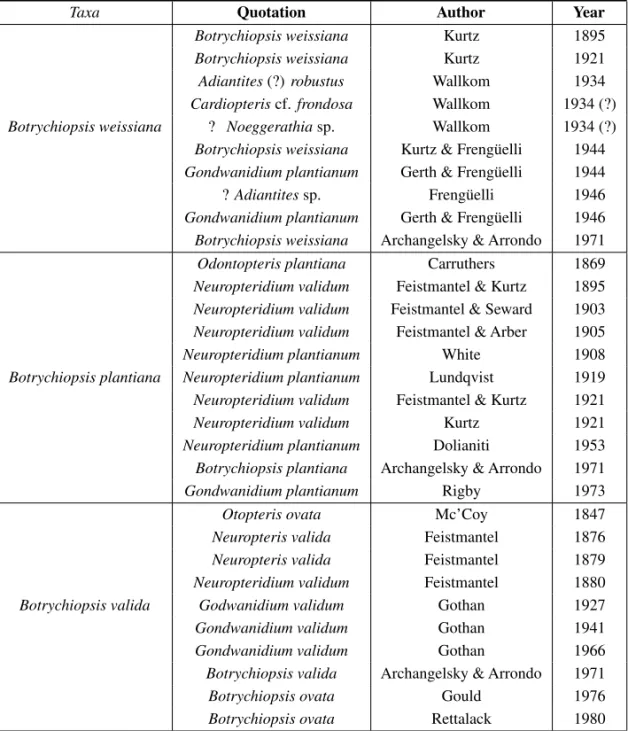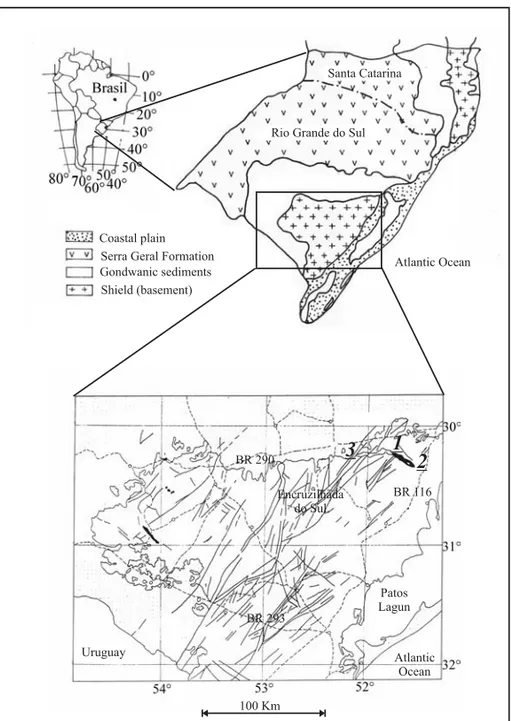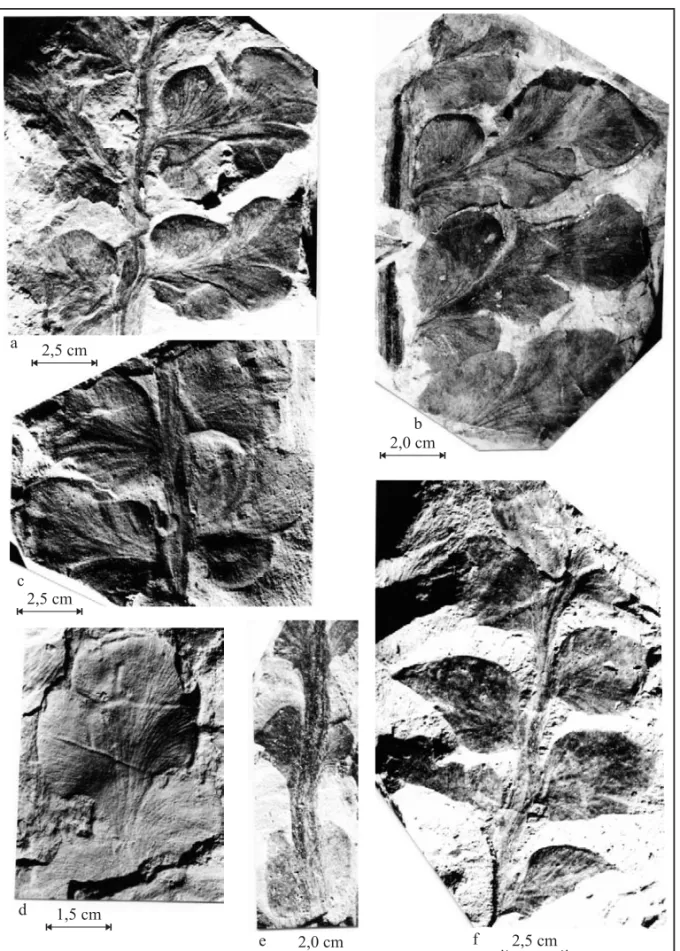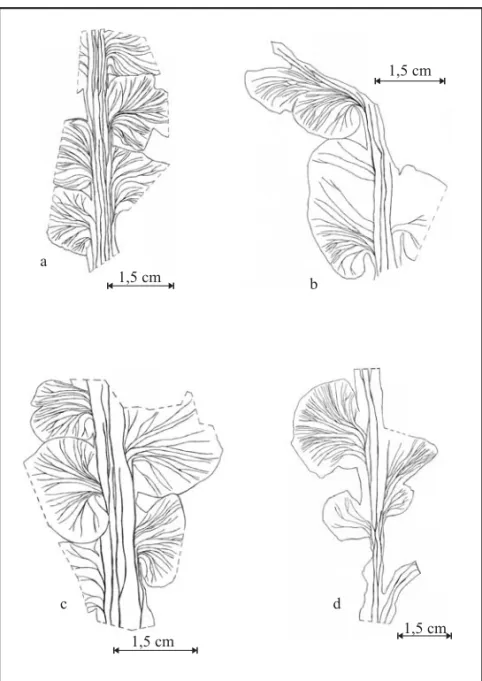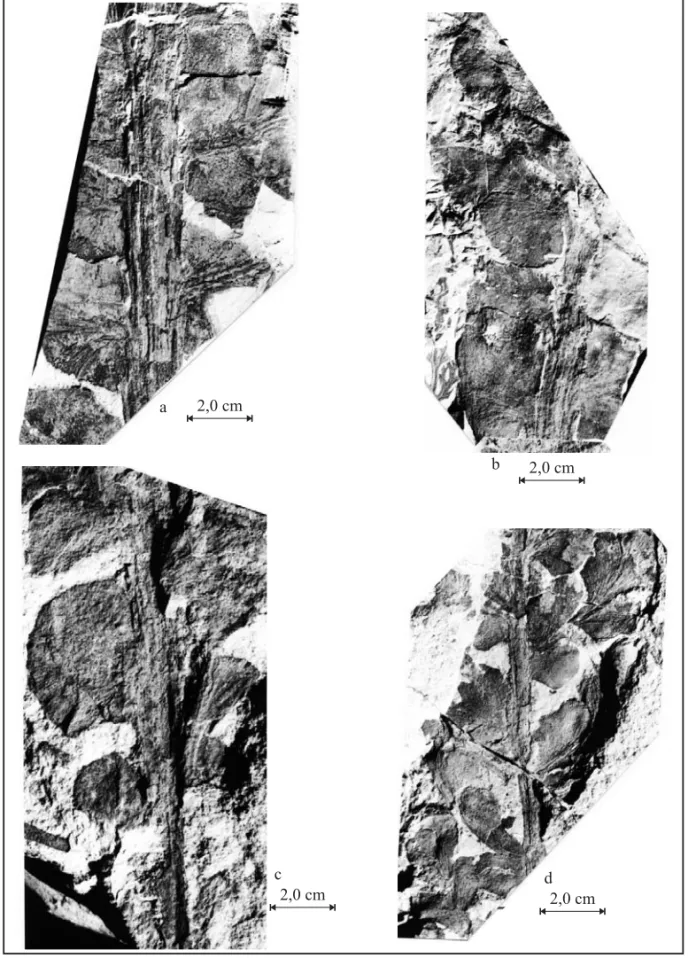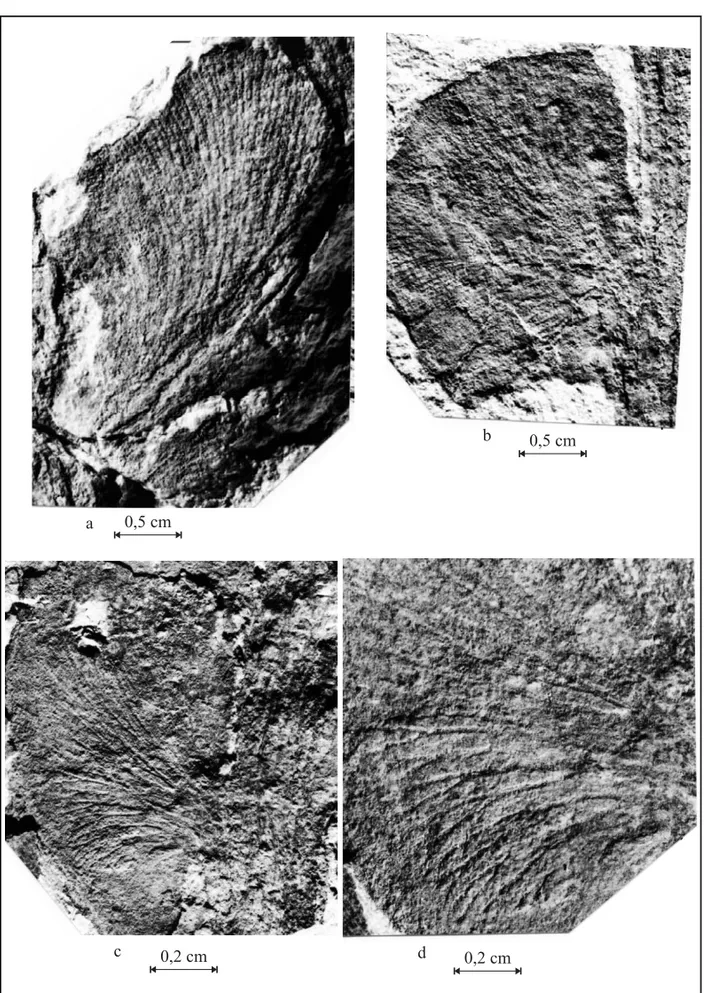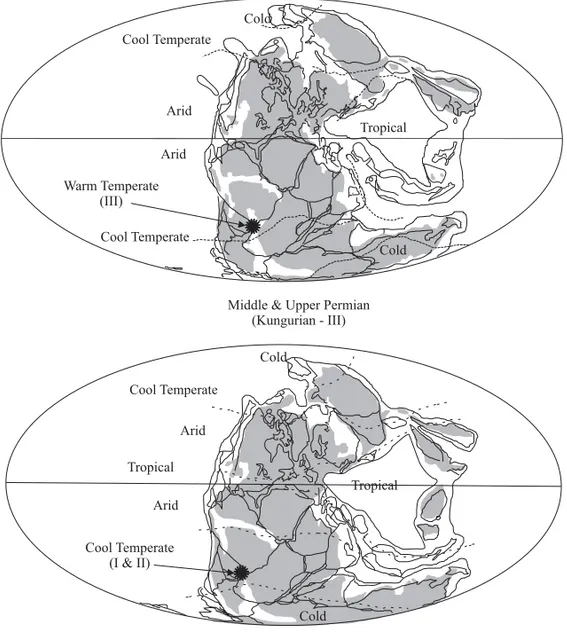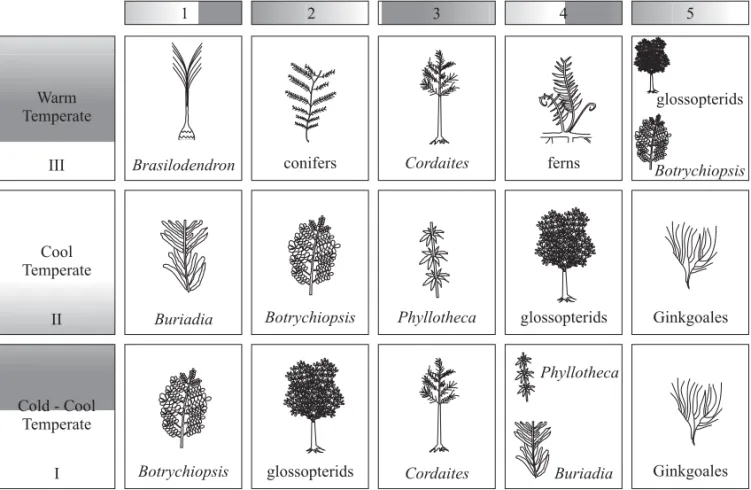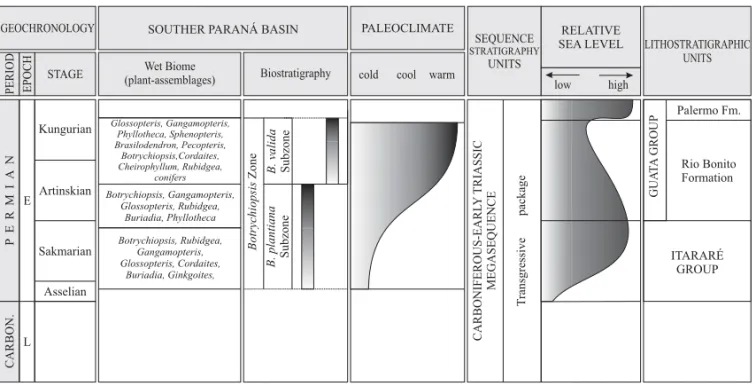www.scielo.br/aabc
The
Botrychiopsis
genus and its biostratigraphic implications
in Southern Paraná Basin
ANDRÉ JASPER1, MARGOT GUERRA-SOMMER2, MIRIAM CAZZULO-KLEPZIG2 and RUALDO MENEGAT2
1Setor de Botânica e Paleobotânica, Museu de Ciências Naturais, Centro Universitário UNIVATES
(SBP/MCN/UNIVATES),95900-000 Lajeado, RS, Brasil
2Instituto de Geociências, Universidade Federal do Rio Grande do Sul (IG/UFRGS)
91501-970 Porto Alegre, RS, Brasil
Manuscript received on February 3, 2003; accepted for publication on July 23, 2003; presented byAlcides N. Sial
ABSTRACT
Botrychiopsishas been considered an important floristic element of Westphalian/Artinskian associations of the Paraná Basin. The occurrence ofBotrychiopsisin roof-shales of the Rio Bonito Formation in Southern Paraná Basin (Quitéria area), supported by the identification ofBotrychiopsis valida, enlarges the genus biochron. Consequently, the stratigraphic hierarchy forBotrychiopsis plantianaandBotrychiopsis valida
was defined for the Paraná Basin. Although it is climatically controlled and related to a deglaciation icehouse stage, stratigraphic distribution of the genus presents a substantial climate tolerance, from cold/cool to warm/temperate conditions. A new phytostratigraphic zonation is proposed for the southern portion of the basin that includes theBotrychiopsisZone (Asselian/Kungurian), which is subdivided into theBotrychiopsis plantiana(Asselian/Artinskian) andBotrychiopsis valida(Late Artinskian/Kungurian) subzones.
Key words:Botrychiopsis, biostratigraphy, Paraná Basin, Permian, palaeoclimatology, Gondwana.
INTRODUCTION
The intracratonic Paraná Basin covers 1.700.000 square kilometers of East and Central South America (1.100.000 square kilometers in Brazil) and encloses Paleozoic, Mesozoic and, locally, Ceno-zoic sedimentary and volcanic rocks. According to Milani et al. (1998), the Paraná Basin comprises six stratigraphic megasequences bounded by interre-gional unconformities (sensuVail et al. 1977). The three lower megasequences (Ordovician – Silurian, Devonian and Carboniferous – Early Triassic) con-sist of transgressive – regressive cycles whereas the three upper megasequences (Late Triassic,
Juras-Correspondence to: André Jasper E-mail: ajasper@univates.br
sic – Early Cretaceous and Late Cretaceous) encom-pass continental strata and volcanic rocks. Each megasequence corresponds to previously proposed lithostratigraphic units.
The Carboniferous – Early Triassic (CET) megasequence represents a second-order sive – regressive cycle. It contains a basal transgres-sive unit overlain by a regrestransgres-sive succession. The basal succession includes the Itararé Group and Rio Bonito and Palermo formations.
514 ANDRÉ JASPER ET AL.
1975, 1979, Cazzulo-Klepzig and Guerra-Sommer 1983, Zampirolli 2001).
The synonymization of distinct taxa to this morphogenus, which is characterized by heteromor-phy, took place for more than a century (1844-1971) during which several Earth Science paradigms were established and abandoned, from the Fixist models to Plate Tectonics. The main studies that produced the current genus conception are presented in Fig. 1. Studies of Archangelsky and Arrondo (1971) demonstrated the biogeographic and biostrati-graphic importance of the genus in Gondwana suc-cessions. These sequences occur in Argentina (Sessarego and Césari 1986, Archangelsky et al. 1987, Archangelsky and Cúneo 1987, Andreis and Archangelsky 1996); Brazil (Millan 1975, 1979, 1987a,b, Rösler 1978, Guerra-Sommer and Caz-zulo-Klepzig 1981, Guerra-Sommer and Cazzulo-Klepzig 1993); South Africa (Rayner 1985, 1986, Rayner and Coventry 1985, Anderson and Ander-son 1985, Kovács-Endrödy 1991), India (Srivastava 1997) and Australia (Rigby 1973, 1993, Retallack 1980).
The paleofloristic assemblages show a homo-geneous composition dominated by foliar organs of plants with arborescent habit as well as remnant shrub-like plants, such asBotrychiopsis plantiana.
Shrub-like plants identified as Botrychiopsis plantianahave also been recorded in the southern-most portion of the Paraná Basin, within the Glos-sopterisFlora and are associated with fluvial, delta and estuarine sedimentary rocks at the base of the Rio Bonito Formation (Pasqualini et al. 1986).
The presence of Botrychiopsis in Paleozoic Gondwana floras of the Paraná Basin has usually been associated with tundra and taiga environments (Archangelsky 1971, 1978, 1984, Rocha-Campos and Archangelsky 1985, Retallack 1980, 1999).
In their description of theGlossopterisFlora Early Permian evolution in Southern Brazil, Guerra-Sommer et al. (1991, 2001) regarded Botrychiop-sis plantiana as a remnant plant from a rigorous periglacial cold climate.
The first records ofBotrychiopsiswithin
roof-shales in Southern Paraná Basin (Quitéria area), as discussed herein, allow to infer the relationship be-tween the biostratigraphic distribution of this genus and its tolerance to climate changes. In this case, cli-mate change has been associated with a deglaciation phase of an icehouse period and is represented by an evolution from cool-temperate to warm-temperate climate. The validation of this hypothesis would then broaden the current parameters used to inter-pret the climatic conditions favorable for the devel-opment of these plants.
This paper comprises the first step of a larger project that aims to evaluate the chronostratigraphic significance of theBotrychiopsiswithin Gondwana. It was carried out to verify earlier taxonomic and biostratigraphic descriptions ofBotrychiopsisforms of the Southern Paraná Basin. This revision was re-quired due to the reduced nature of previous descrip-tions, which did not define the diagnostic differences between previously identified and original material.
REVIEW OF THEBotrychiopsisOCCURENCE IN SOUTHERN PARANÁ BASIN
Forms related toBotrychiopsishave been identified in Rio Grande do Sul State in Faxinal, Base of Morro Papaléo and Quitéria outcrops (Fig. 2).
The Faxinal outcrop, described by Morgenthal et al. (1970) and later by Andreis et al. (1979), is located in the northeastern portion of the Barão do Triunfo topographic Sheet, close to the confluence of the Grande and Faxinal creeks, about 10 km west-northwestward from the Mariana Pimentel District. The exposure includes variable amounts of sandstone and mudstone related to the uppermost part of the Itararé Group in the Rio Grande do Sul State. It represents the westernmost exposure of a paleovalley that extends from Potreiro Grande, 4 kM eastwards from the Mariana Pimentel District.
Glos-Taxa Quotation Author Year
Botrychiopsis weissiana Kurtz 1895
Botrychiopsis weissiana Kurtz 1921
Adiantites(?)robustus Wallkom 1934
Cardiopteriscf.frondosa Wallkom 1934 (?)
Botrychiopsis weissiana ? Noeggerathiasp. Wallkom 1934 (?)
Botrychiopsis weissiana Kurtz & Frengüelli 1944
Gondwanidium plantianum Gerth & Frengüelli 1944
?Adiantitessp. Frengüelli 1946
Gondwanidium plantianum Gerth & Frengüelli 1946
Botrychiopsis weissiana Archangelsky & Arrondo 1971
Odontopteris plantiana Carruthers 1869
Neuropteridium validum Feistmantel & Kurtz 1895
Neuropteridium validum Feistmantel & Seward 1903
Neuropteridium validum Feistmantel & Arber 1905
Neuropteridium plantianum White 1908
Botrychiopsis plantiana Neuropteridium plantianum Lundqvist 1919
Neuropteridium validum Feistmantel & Kurtz 1921
Neuropteridium validum Kurtz 1921
Neuropteridium plantianum Dolianiti 1953
Botrychiopsis plantiana Archangelsky & Arrondo 1971
Gondwanidium plantianum Rigby 1973
Otopteris ovata Mc’Coy 1847
Neuropteris valida Feistmantel 1876
Neuropteris valida Feistmantel 1879
Neuropteridium validum Feistmantel 1880
Botrychiopsis valida Godwanidium validum Gothan 1927
Gondwanidium validum Gothan 1941
Gondwanidium validum Gothan 1966
Botrychiopsis valida Archangelsky & Arrondo 1971
Botrychiopsis ovata Gould 1976
Botrychiopsis ovata Rettalack 1980
Fig. 1 – CurrentBotrychiopsisgenus conception.
sopteris,GangamopterisandGinkgoitesgenera as well as articulate stems and conifer branches are also present.
According to Andreis et al. (1979) both white and grayish brown facies represent the final filling stage of large lakes, and considered then as related to the end of the Itararé Group sedimentary cycle (Corrêa da Silva 1970 and Bossi and Piccoli 1979). According to Milani et al. (1998), these sedi-ments correspond to lowland glaciocontinental
sed-iments, deposited during the deglaciation produced by warming of a glacial climate.
The specimens hereby presented were previ-ously studied by Guerra-Sommer et al. (1980) and Cazzulo-Klepzig and Guerra-Sommer (1983) and are stored (samples PB 3097 e PB 3098) in the Pale-obotanic Sector of the Earth Sciences Institute of the Federal University of the Rio Grande do Sul State (UFRGS).
516 ANDRÉ JASPER ET AL.
Fig. 2 – Localization of the Faxinal (1), Base of Morro Papaléo (2) and Quitéria (3) outcrops.
of long bipinnate fronds (3,9 to 8,2 cm long and 0,6 to 2,9 cm wide). They present a main robust rachis, between 0,6 cm (proximal part) and 0,2 cm (distal portion) wide, which features a solid longitu-dinal nervure (Fig. 3b). From the widely decurrent (Fig. 3e), separated (Fig. 3f) to slightly imbricated (Fig. 3b) rachis, minor sessile pines displaying com-plete limbus emanate with a somewhat acute angle of insertion (50˚ a 70˚). The pines outline is subcir-cular and either smooth (Fig. 3f) or showing small insertions (Fig. 3a,b, and d). These insertions
may present an asymmetrical, subcircular to slightly oblong outline.
The associated microflora, composed of trilete spores (75%) and monosaccate pollen (15%), rare bisaccate and striate pollens, was related by An-dreis et al. (1979) to the H1/H2 biostratigraphic interval of Daemon and Quadros (1970). It cor-responds to the upper part of the Potonieisporites-Lundbladispora Zone proposed by Archangel-sky and Marques-Toigo (1978) for the Chaco-Paraná Basin (Argentina). According to Andreis et al. (1979), this interval is equivalent to either the Stephanian C – Sakmarian boundary or, according to Faddeieva (1976), to the base of the Asselian in Russia.
The outcrop Base Morro Papaléo is situated in the Barão do Triunfo topographic sheet (SH-22-0-1-2), 8 Km northwestward of Mariana Pimentel. It is located in a ravine on the lower part of the southwest-ern border of the Morro Papaléo (UTM 0438317 E and 6647584 N).
This outcrop, described by Pasqualini et al. (1986), comprises an alternation of carbonaceous, fossiliferous siltstone, mica-rich, fine-grained sand-stone, lenticular, coarse-grained sandstone and glomerate, and sandstone exhibiting iron-rich con-cretions. Plane bedded siltstone and sandstone and cross-bedded sandstone are common sedimentary features.
Pasqualini et al. (1986) related the fossiliferous beds to the bottom of efemerous water bodies asso-ciated with the margins of interdistributary lakes.
The taphoflora is mostly composed of glos-sopterids with pinnate venation (Glossopteris com-munis,Glossopteris indica) andBotrychiopsis plan-tianaassociated with articulates (Phylloteca indica) and conifers (Buriadia isophylla). Gangamopteris
sp., Glossopteris angustifolia, Cordaites and pro-toglossopterids (Rubidgea obovata) occur as minor elements.
Some specimens formerly described by Pas-qualini et al. (1986) were analyzed herein, as well as others stored in the Paleobotanic Sector of the Earth Science Institute at UFRGS.
The samples comprise basal and medial-basal fragments of elongated and bipinnate fronds (3,8 to 9,0 cm long and 0,6 to 7,9 cm wide). They present a robust main rachis, with strong longitu-dinal nervures, which can be 0,9 cm wide at its proximal portion and disperse at the more distal pines (Fig. 3b). In a subordinate way, and show-ing somewhat acute insertion angles (50˚ to 70˚), sessile, widely decurrent to pseudopetiolate pines emanate from the rachis. They change from iso-lated to slightly imbricated, show complete limbus, and can either present or lack insertions on their bor-ders, therefore producing their bipinnate aspect.
The pines from the basal portions of the fronds are decurrent and separated (Fig. 3e) to fairly im-bricated (Fig. 3b). They can present rhomboidal (Fig. 3e), ovoid (Fig. 3f) or rhomboidal-elongated (Fig. 3b) outlines with no insertions. They are 0,8–1,8 cm long and 1,3–1,8 cm wide. These pines present an open venation, derived from the rachis nervures, which is denser at its base, disperses at the apex and can dichotomize twice to three times. The pines from the medial-basal portions of the fronds are rather imbricated and change from exten-sively decurrent to pseudopetiolate. They present ei-ther an elliptical-elongated or oblong-elliptical out-line that can display slight to strong insertions on their borders. In this latter case a bipinnate mor-phology is produced and the lobes correspond to the pinnules. The pine length spans from 0,7 to 5,4 cm and their width between 0,9 and 2,8 cm. They present an open venation, derived from the rachis nervures, which is denser at its base and more dis-perse along the pinnules. As the nervures go along the pinnules they suffer dichotomy, from twice to four times. The pinnules are strongly decurrent and the more developed ones are free down to their base. They always present an asymmetrical outline that can be subcircular to slightly oblong (Fig. 3).
518 ANDRÉ JASPER ET AL.
and a rachis (0,6 cm wide) with strong longitudinal nervures. From the rachis subaltern, separated, ses-sile, extensively decurrent pines emanate, exhibiting entire limbus, slightly acute insertion angles (50˚ a 70˚) and a reniform morphology. These pines are 0.6 cm long and 1.3 cm wide and show venation derived for the rachis nervures. Venation is open, denser at its base (dispersing towards the apex) and can dichotomize twice to three times.
Samples from Base of Morro do Papaléo lack spores and pollen probably due to non-preservation. The Quitéria outcrop is located in the Pan-tano Grande County (Rio Grande do Sul State), in the southeastern border of the Paraná Basin (UTM 0387516 E and 6643183 N). It is about 130 km from Porto Alegre, along the BR 290 freeway, and can be localized in the Quitéria topographic sheet (SH22-NH). It comprises a sedimentary package about 8 meters thick, characterized by the intercalation of carbonaceous shale, argillite, fine- to coarse-grained sandstone, matrix-supported (silty to sandy) con-glomerate and thin, up to 25 cm thick coal beds.
The fronds are preserved in a light-yellow, fine-grained sandstone bed (45 cm thick) that exhibits plane bedding and is situated immediately above a carbonaceous argillite bed. Both horizontal and in-situ lycophyte stems (Brasilodendron) occur in as-sociation with this level, as well as Coniferophyta,
Cordaites, Filicophyta and scattered fragments of glossopterids (Rubidgeasp. andGlossopterissp.).
Piccoli et al. (1991) related the sedimentary succession to a delta system dominated by low-energy fluvial processes, with well-developed allu-vial plain facies and peat-forming swamps in the interdistributary lowlands.
Based on specific features, mostly those re-lated to lycophyte specimens of theBrasilodendron
genus, and previous regional stratigraphic studies (Menezes 1994, Chaves et al. 1994, Della Fávera et al. 1994, Holz 1995, Lopes and Lavina 1995, Holz 1997) Jasper and Guerra-Sommer (1999) suggested a barrier-lagoon system (and associated washover fans), similar to the model formulated by Reison (1992).
The samples are stored in the Botany and Pa-leobotany Sector of the UNIVATES Natural Sci-ences Museum and in the Paleobotany Sector of the DPE/UFRGS.
The samples from Quitéria include basal and medial-basal fragments of elliptical, elongated and bipinnate fronds (3,5 to 11,6 cm long and 0,4 to 5,1 cm wide). They present a robust main rachis (0,1 to 0,9 cm thick) that encompasses strong lon-gitudinal nervures (Fig. 4 and Fig. 5a) from which sessile pines in a sub-opposite trend emanate with slightly acute insertion angles (60˚ to 80˚). These pines are decurrent to extensively decurrent, sepa-rated to slightly imbricated, and present complete limbus, with (bipinnate morphology) or without in-sertions on their borders.
The pines of the frond basal portions are widely decurrent and either separated (Fig. 4b and d and Fig. 5c) or slightly imbricated (Fig. 4a and c and Fig. 5a). They present a rhomboidal (Fig. 4d and Fig. 5c), rhomboidal-elongated (Fig. 4c and Fig. 5a), rhomboidal-widened (Fig. 4a) or reniform outline (Fig. 4b and Fig. 5b) on which insertions are some-times observable (Fig. 4 and Fig. 5). Pines are 0,4 to 1,1 cm long and 0,8 to 2,5 cm wide. Pine ve-nation, derived from the rachis nervures, is open, denser towards its base and disperse at its apex, and dichotomize twice to four times (Fig. 4 and Fig. 6). The pines of the medial-basal portions of the fronds are slightly imbricated and vary from de-current (Fig. 6b) to extensively dede-current (Fig. 6a). They present an elliptical or elliptical-elongated out-line and can present insertions (bipinnate morphol-ogy) on their borders (Fig. 6d). Their lengths vary from 0,5 to 5,0 cm and their width from 0,7 to 2,8 cm. These pines display an open venation, derived from the rachis nervures, which is denser at its basal and central portions and disperses along the pinnules. As the nervures go along the pinnules they dichotomize twice to four times (Fig. 4 and Fig. 6). Pinnules are strongly decurrent and the more developed ones are free down to their base, presenting a subcircular to elliptical-elongated outline.
520 ANDRÉ JASPER ET AL.
Fig. 4 –Botrychiopsis validafronds from Quitéria. (a) middle portion of a frond with pines, showing the venation of the rachis, the insertion of the pines in the rachis and is venation – PbU 0281; (b) middle portion of the frond with complete limbus presenting small insertions and the venation of the rachis and pines – PbU 0233; (c) basal portion of the frond with the insertion of the pines and venation – PbU 0252; (d) basal portion of the frond with the insertion of the pines and venation – PbU 0062.
coalbeds of Quitéria outcrop has shown the pres-ence of well preserved, abundant and diverse mi-croflora. It is mainly composed of trilete spores, 70% produced by pteridophytes, less frequent to rare Gymnospermae pollens, alga, acritarchs and incer-tae sedis. Zonati and Cingulicavati spores, related to herbaceous and shrub-like Lycophyta, mainly
522 ANDRÉ JASPER ET AL.
Apiculatisporis, Granulatisporites, Cyclogranis-poritesandConvolutisporagenera.
Monosaccate pollen (Plicatipollenites, Cahe-niasaccites,Potonieisporites andCannanoropollis
genera) is less common and indicates the occur-rence of Cordaitophyta. On the other hand, bisac-cate pollen, such asScheuringipollenites, Vesicas-poraandLimitisporites, is related to Glossopterido-phyta.
The identified striated pollen specimens have a botanical affinity with Coniferophyta, such as Proto-haploxypinus,VittatinaandLunatisporites. Mono-lete spores are rare and essentially represented by forms ofCycadopites.
Due to the predominance of species related to Zonati and Cingulicavati spores the palynoflora is comparable, in the Paraná Basin, to the microfloris-tic association identified in the Candiota Superior and Banco Louco beds in the Candiota Coalfield by Meyer (1999).
Among the spore-pollinnic associations pro-posed by Marques-Toigo and Corrêa da Silva (1984) for the coal measures of the Rio Grande do Sul State, this type of palynoflora is comparable to the Pun-tatisporites,LundbladisporaandPortalites Associ-ation, which is related to plants of hydrophylous to hygrophilous environments.
In terms of biostratigraphy, the microflora identified in the Candiota Upper Coal Seams was included in theCaheniasaccites ovatusZone of Mar-ques-Toigo (1988) – Artinskian/Kungurian. Based on isotopic dating of tonstein beds interbedded in the coal seams, Cazzulo-Klepzig (2001) linked this zone to Late Kungurian/Early Roadian age.
Palynological analyses on samples from Quité-ria confirm its correspondance with the Caheniasac-cites ovatusbiozone (Kungurian/Early Roadian).
TAXONOMIC AFFINITIES
In this chapter, the taxonomic affinities of the previ-ously described material (Faxinal, base of the Morro Papaléo and Quitéria) are re-evaluated.
The morphological features of the studied
spe-cimens indicate affinities with theEusphenopteris
Novik (1947) andBotrychiopsis(Kurtz) Archangel-sky and Arrondo (1971).
The Eusphenopteris Novik (1947) genus is characterized by a bipinnate frond, with alate rachis and alternated pines. These pines show a poorly defined rachis as the pinnule limbus presents decurrent spreading. Pinnules are trilobate and deeply incised, with an open, dichotomized vena-tion that arises from a central nervure starting from the rachis. Within Carboniferous Gondwana succes-sions these forms have been considered intermediate between Botrychiopsis andDactylophylum (Zam-pirolli 2001). In Western Gondwana this genus was recorded by Cúneo (1990), in the Mojón de Hierro Formation (Upper Paleozoic Tepuel Group), Arroyo Garrido area (Chubut Province of Argentina). It was also found by Zampirolli (2001), in the Santa Marta Farm (Itapeva region in the São Paulo State), within Neo-Carboniferous interglacial rocks (Itararé Sub-group of the Paraná Basin).
Based on previous studies (Archangelsky et al. 1987, Archangelsky and Cúneo 1991, Iannuzzi 1994, Ricardi 1994, Iannuzzi et al. 1998), Iannuzzi and Rösler (2000) have stated that the
Eusphenopterisgenus was a rare component of the
Archeosigillaria/ Lepidondrops/ Frenguellia, Euro-american and Northern Rhacopteris Nothorha-copterisfloras, although common in the Southern
NothorhachopterisFlora, during the Carboniferous. Among the main features of theEusphenopteris
genus are its tripinnate frond with trilobate pinnules, deeply incised margins and subtriangular outline, showing an open and dichotomized venation that arises from a single and thick nervure going into the pinnules from the rachis. Although presenting an open and dichotomized venation in the pinnules, the studied material does not show all other features of theEusphenopterisgenus.
The morphology of the analyzed material points towards the Botrychiopsis (Kurtz) Archan-gelsky and Arrondo (1971).
morpho-524 ANDRÉ JASPER ET AL.
logical and taxonomic data, but also stratigraphic implications, was presented by Archangelsky and Arrondo (1971). The authors, based on Argentinean material and relating it to Gondwana and extra-Gondwana data, confirmed Kurtz’s (1895a, b) orig-inal interpretations. A new diagnosis was defined and the concepts of frond, pines and pinnules were reviewed. Furthermore, descriptive features diag-nostic of the following three species were presented:
Botrychiopsis weissiana(Kurtz) Archangelsky and Arrondo (1971), Botrychiopsis plantiana (Carru-thers) Archangelsky and Arrondo (1971) and Botry-chiopsis valida(Feistmantel) Archangelsky and Ar-rondo (1971), the latter only compared with the Up-per Paleozoic of India. According to Archangelsky and Arrondo (1971) the different species present a wide geographic distribution and clear chronostrati-graphic boundaries that allow some phylogenetic as-sumptions in terms of an ascendancy of Botrychiop-sis weissianain relation toBotrychiopsis plantiana, and of this one toBotrychiopsis valida.
Cúneo (1990) confirms the genus features pointing out that the pines are arranged in a slightly subopposite way, with a rachis that goes to the base of the apical pinnule. Furthermore, pines are lobate with deccurent insertions, its venation is open and can be dichotomized up to three times.
In this study, both generic and specific propo-sitions of Archangelsky and Arrondo (1971) are ac-cepted. A pteridophytic or pteridospermic affinity has been proposed for this genus.
Considering the original diagnosis of Kurtz (1895a,b), emended by Archangelsky and Arrondo (1971),Botrychiopsis weissianapresents some fea-tures that were not seen in the studied samples of the Faxinal and Base of Morro Papaléo outcrops. The morphological characters of Botrychiopsis weis-sianainclude an alate basal portion of the frond, a twisted insertion of the pines with a pronounced im-brication, and an ovoid-spatulated morphology of the frond apical pinnule.
Similarly, it is not possible to correlate the stud-ied samples with Botrychiopsis valida. In Feist-mantel’s (1879) previous description, also emended
by Archangelsky and Arrondo (1971), this species presents divided basal frond pinnules, confluent along the entire frond and presenting subrhombic morphology with sinuous margins. These charac-teristics are not present in the studied samples.
The main morphological features of this mate-rial are apical, medial and medial-basal fragments of the pines. The pines have long and bipinnate fronds presenting a robust main rachis that can dis-perse in the distal pines. The rachis presents strong longitudinal nervures from which minor sessile pin-nules radiate displaying slightly acute insertion an-gles (50˚ to 70˚). The pinnules are generally decur-rent to pseudopetiolate, separated to slightly imbri-cated, presenting entire limbus with or without inser-tions on their borders. They may assume a sublobate morphology, from rhomboidal, rhomboidal-ovaled or rhomboidal-elongated to elliptical, elliptical-elongated or oblong-elliptical morphology. They present an open venation derived from the rachis nervures, which is denser at their base and disperse along their limbus, which can dichotomize twice to four times. These elements link this material toBotrychiopsis plantiana(Archangelsky and Ar-rondo 1971).
This conclusion is reinforced by comparative analysis of the samples discussed herein and the specimens shown by Archangelsky and Arrondo (1971, Slide V, Fig. 1 and 2, Slide VI, Fig. 1, 2 and 3) and their diagnoses.
This review also confirms the designations of Guerra-Sommer et al. (1980), Cazzulo-Klepzig and Guerra-Sommer (1983) and Pasqualini et al. (1986).
Botrychiopsis valida
The Quitéria frond samples were not correlated to
Botrychiopsis weissianadue to the lack of some crit-ical morphologcrit-ical features, such as the basal por-tion of the alate frond, the twisted inserpor-tion of the pines displaying heavily delineated imbrication and the ovoid-spatulated morphology of the frond apical pinnules.
the absence of characteristics such as the connected to slightly imbricate pinnules of the frond base and the spatulate shape with the rounded distal margin of the apical pinnules.
However, these specimens can be correlated to another species, Botrychiopsis valida, taking into account the material described by Feistmantel (1880), Archangelsky and Arrondo (1971), Rigby (1973), Anderson and Anderson (1985) Gould (1975), Retallack (1980), Rayner (1995), Rigby (1985) and Archangelsky and Cúneo (1981).
The pines and pinnules morphology along the fronds supports the identification of the Quitéria ma-terial withBotrychiopsis valida. Among the main features used for its identification the presence of a robust and well-defined main rachis can be consid-ered, with solid longitudinal nervures, from which subopposite sessile pinnules emanate with slightly acute insertion angles (60˚ to 80˚). These pinnules are extensively decurrent to decurrent, separated to slightly imbricated, and have entire limbus present-ing, or not, insertions on their borders.
Furthermore, the decurrent aspect of the sepa-rated basal pines, with rhomboidal, elongate-rhomboidal or reniform outline, are very similar to the material previously related toBotrychiopsis plantianaby Gould (1975, Fig. 3C and D) and later on toBotrychiopsis validaby Retallack (1980).
Some other aspects also evidence the associa-tion of the specimen hereby analyzed to Botrychiop-sis valida, largely by comparison with the mate-rial described and synonymized by Archangelsky and Arrondo (1971) as well as that identified by Rigby (1973), Anderson and Anderson (1985), Gould (1975), Retallack (1980) and Rayner (1995). Among these evidences, the presence of slightly imbricate, highly decurrent to decurrent pinnules with elliptical or elongated-elliptical outline and sub-lobate border insertions was observed. The pin-nules present an open venation, derived from the rachis nervures, denser at their basal and central portions and dispersing along the upper portions of the pinnules, which dichotomize twice to four times (similar to the basal pinnules).
Botrychiopsis validawas previously described asNeuropteris validaby Feistmantel (1876) within Eopermian sedimentary successions of India. Later, Feistmantel (1879, 1880) again mentioned the same species, also within Indian sedimentary rocks. Gothan (1927) registered the presence of Gondwani-dium validumin the Serra de los Llanos (Argentina). Archangelsky and Arrondo (1971) synonymized all these specimens toBotrychiopsis valida, stressing that this species was restricted to India. In their spe-cific description, Archangelsky and Arrondo (1971) highlight that the frond base presents well-defined, subcircular to slightly elongated and clearly sepa-rated pinnules with a large insertion base. The pines present normal insertions and vary from slightly im-bricate to united. The highest number of pinnules per pine (up to 5 cm long) is five. The usual in-sertion angles range from 70˚ to 80˚. All pinnules are convergent, the apical ones presenting a sub-rhombic morphology with sinuous margins. Ac-cording to Archangelsky and Arrondo (1971), an-other important aspect of this species is the pres-ence in the medial portions of the frond of just pro-duced pines. These pines present fused pinnules at their base and free ones at their apical portions. Similar features are reported by Anderson and An-derson (1985, pl. 167, Fig. 2) and can be seen in the material presented herein. However, Retallack (1980) considered the designation of Botrychiop-sis valida, defended by Archangelsky and Arrondo (1971), asnomen vanumand sinonymized to Botry-chiopsis ovata (Mc’Coy). Retallack (1980) also states that the specimen classified as Botrychiop-sis plantianaby Gould (1975, Fig. 3C, D) should also correspond to theBotrychiopsis ovataspecies. Later, Rigby (1985) suggests, keeping the Botry-chiopsis ovata species, including in this species other taxa such asOtopteris ovataMc’Coy (1847, p. 148; pl. IX, Fig. 2),Aneimites austrinaEtheridge (1888, p. 1304; pl. 37),Cardiopteris polymorphain White (1969a,b; p. 98; plates A and B, Fig. 1), Gond-wanidium plantianumin Rigby (1973, p. 4-5; plate 1, Fig. 2 and plate 2 Fig. 3),Triphyllopteris austrina
526 ANDRÉ JASPER ET AL.
k, u),Botrychiopsisin Retallack (1980, p. 394-395; Fig. 21.3 E-G) andOtopteris ovatain Archangelsky (1983, p. 161-163; pl. 1-3).
Even so, in this paper the designation Botry-chiopsis valida is maintained in accordance with Archangelsky and Arrondo (1971) criteria.
THE BIOSTRATIGRAPHIC IMPLICATIONS OF THEBotrychiopsisGENUS IN
SOUTHERN PARANÁ BASIN
The Botrychiopsis genus was proposed by Kurtz (1895a,b), based on Carboniferous material of the Rio Jejenes Formation (San Juan Province, Argen-tina). Similar forms, previously recorded by Fren-güelli (1944, 1946, 1954) under other denomina-tions, were identified by Archangelsky and Arrondo (1971) asBotrychiopsis weissiana.
According to Archangelsky and Arrondo (1971), the description of distinct biocrons for the species of theBotrychiopsisgenus highlights not just its phylogenetic relationship but also its chronos-tratigraphic importance. The phylogenetic associ-ations come from theBotrychiopsis weissianaand
Botrychiopsis plantiana sequential record within Argentinean Gondwana associations. Forms related to Botrychiopsis valida would also be descended fromBotrychiopsis weissianadeveloped in distant areas, hence differentiating from the Western Gond-wana coeval forms. Based on these evidences and the inferences of Gothan and Sahni (1937), it seems that the group development occurred from an ances-tral stock identified in Peninsular India and Ausances-tralia Namurian successions.
However, some aspects of this evidence, such as the presence of Botrychiopsis weissianaand
Botrychiopsis plantianaas coeval elements within Argentinean Paleozoic floras (Archangelsky and Azcuy 1985), suggest the need of re-evaluating pre-supposed phylogenetic relations. Although these data support the idea that the specific relations should be reviewed, studies on distinct basins have confirmed the stratigraphic importance of the differ-ent morpho-species.
In a first inference to the Botrychiopsis
chronostratigraphic impact Archangelsky and Ar-rondo (1971) indicated a time span from Upper Car-boniferous (Westphalian) to Lower Permian (Artin-skian) for the genus. TheBotrychiopsis weissiana
biochron was restricted to the Carboniferous Sys-tem (Tupense local age – Westphalian/Stephanian of Western Europe). This geochronological posi-tion was corroborated by marine invertebrates (An-telo 1972) and palynology (Menéndez 1965).
Botrychiopsis plantianais linked to the earliest Conifers and Ginkgoales occurrences in the Tram-peadero and Libertad formations (Paganzo Basin), in Upper Carboniferous sequences of Trampead-erense local age.
The record of Botrychiopsis plantianain the Nueva Lubecka Formation, referred to the Lube-kense A/B (Sakmarian/Artinskian), according to pa-lynological and marine invertebrates (Antelo 1972), is considered as a Carboniferous relict.
Archangelsky and Arrondo (1971) considered
Botrychiopsis validaas exclusive to Indian succes-sions (Kaharbari Formation). The age interval was attributed to the Artinskian through the analysis of marine invertebrates (Robison 1967), hence com-prising the youngest species of the genus (Archan-gelsky and Arrondo 1971).
In the Paraná Basin, Carruthers (1869) regis-teredBotrychiopsis plantianain coal-bearing strata, later namedOdontopteris plantiana. White (1908) and Lundqvist (1919) designated the same form with the epithet Neuropteridium plantianun. Dolianiti (1948) named similar species found in the Itararé Group of the Rio Grande do Sul State (Acampa-mento Velho outcrop) as Gondwanidium plan-tianum.
available type-material studied by Millan (1975, 1979), which is now kept in the Museu Nacional (UFRJ), it is impossible to establish the specific affinity of the material. Therefore, the specimens de-scribed by Millan (1975, 1979) remain here termed
Botrychiopsissp.
On the informal phytostratigraphic zonation of the Late Paleozoic Paraná Basin, Rösler (1978) recorded the presence of Botrychiopsis plantiana
in Taphoflora A, relating it to the early stages of deglaciation in the Paraná Basin (Sakmarian/ Artinskian). Andreis and Archangelsky (1996), in a review of the Neopaleozoic basins of South Amer-ica, related the Taphoflora A to a probable Stepha-nian age, taking into account the lack of the Glos-sopterisgenus. According to Guerra-Sommer and Cazzulo-Klepzig (1981) the Itararé Group tapho-flora in the Rio Grande do Sul State, including Botry-chiopsis plantiana, can be related to the Cerquilho (Taphoflora A and B of Rösler 1978) and Argen-tinean Bajo de Veliz (Lubekense A) taphoflora.
Studies of Millan (1987a) on the megafloris-tic association of coal-bearing strata from Itapeva (São Paulo State) – the Santa Marta Flora of the Itararé Group – record a large amount of Botrychiop-sis plantianafronds and subordinate Sphenopsida (Paracalamites,Sphenophyllum), Cordaitales ( Cor-daites) and platispermics seeds (Cordaicarpus). An Itapevense local age was indicated for this associa-tion.
In an attempt to define floristic stages for coal-beds of the Itararé Group, Millan (1987b) correlated the Monte Mor Taphoflora (Montemorense Stage) to the Trampeaderense Megafloristic Zone of the Argentinean Paganzo Basin (Azcuy and Jelin 1980). This taphoflora is regarded as Westphalian/ Stephanian and correlated to the Potonieisporites-Lundbladispora Zone (Archangelsky and Césari 1986). According to Millan (1987b),Botrychiopsis plantianais the leading element of the Itapevense Sub-Stage (Itapeva Flora). A Stephanian age for the Itapevense Sub-Stage was estimated by correlation with palynological data (Lima et al. 1976).
Zampirolli (2001) carried out a detailed review
of the formerly described Santa Marta Taphoflora (Millan 1987a), using the same material that is now stored in the National Museum (Universidade Fed-eral do Rio de Janeiro). In this review, in addition to
Botrychiopsis, other important diagnostic elements have been included, such asSphenopterissp. and
Nothorhacopteris cf. argentinica. Palynological data from the same strata are comparable with the
Ahrensisporites cristatusInterval Zone of the Itararé Group lower portion (Zampirolli et al. 2000, Souza 2000). Taking in account mega- and microfloristic data, Zampirolli (2001) estimated a Westphalian age for the Santa Marta Flora. According to Zampirolli (2001) this association is comparable to the NBG Zone of Argentina (Middle to Late Carboniferous – Tupense – according to Archangelsky and Cúneo 1991).
In a study on the biostratigraphic importance of the upper Paleozoic taphofloras in Southern Paraná Basin, Guerra-Sommer and Cazzulo-Klepzig (1993) characterized some morphogenera as very impor-tant in terms of dating and correlation. In their at-tempt to establish paleofloristic associations based on observable boundaries of lithostratigraphic units,
Botrychiopsis plantiana(recorded in the Faxinal and Francisquinho outcrops by Andreis et al. 1979) was regarded as one of the main elements related to the interval of deposition of the Itararé sequences in the Rio Grande do Sul State (Sakmarian).
Botrychiopsis plantianaremains a significant component of the Eopermian Glossopteris flora, then associated withGlossopteris,Gangamopteris,
Phyllotheca, Buriadia (Pasqualini et al. 1986), which was related by Guerra-Sommer et al. (1986) to the basal sequences of the Rio Bonito Formation. In a preliminary biozoning of the South-ern Paraná Basin (Guerra-Sommer and Cazzulo-Klepzig 1993) theBotrychiopsis plantianaZone was identified (Itararé Group and base of the Rio Bonito Formation) and related to the Sakmarian-Artinskian. The main feature of the lower subzone ( Gang-amopteris angustifolia) is the predominance of
lancio-528 ANDRÉ JASPER ET AL.
Fig. 7 – Palaeomaps of megafloristic associations in biomes at cold-cool, cool (I-II) and warm temperate (III) climates in the Lower and Midle/Upper Permian (Adapted from Scotese 2002).
latus) and the first glossopterids, mostly represented byGangamopteris(Gangamopteris obovata, Gang-amopteris buriadica and Gangamopteris angusti-folia). Glossopteris (Glossopteris communis and
Glossopteris indica) occur as complementary ele-ments. ThePhyllotheca indicaSubzone comprises elements related to articulate (Phyllotheca indica) associated withGlossopteris(Glossopteris commu-nis) and Conifers (Buriadia isophylla).
Recent data have shown that paleofloristic evo-lution in the Southern Paraná Basin during deposi-tion of the Carboniferous – Early Triassic
Megase-quence was closely related to palaeoclimate, in addi-tion to biostratigraphic and paleoecological controls (Guerra-Sommer et al. 2001). This assumption was confirmed by the evaluation of taphofloristic param-eters from different biostratigraphic units.
Fig. 8 – Megafloristic associations in biomes at cold-cool, cool and warm temperate climates in the Lower and Midle/Upper Permian in Southernmost Paraná Basin, Brazil. (1) Predominant; (2) Abundant; (3) Commom; (4) Less commom; (5) Rare. (I) Asselian wet biome; (II) Sakmarian/Artinskian wet biome; (III) Kungurian wet biome.
Cordaitales, Ginkgoales, Coniferales, in addition to the herbaceous articulates, indicates an Early Artin-skian climate warming.
Glossopterids with pinnate venation and re-lated to Glossopteris are common in Early Per-mian coal-bearing strata (Artinskian/Kungurian) whereas Gangamopteris (palmate form) is poorly represented. The sudden enrichment of filicoid fronds is characteristic of the landscape units in this stage. Arborescent lycophyte communities become important, associated with glossopterid-dominated communities. This event coincides with the wan-ing of the Permian icehouse stage, which reached its peak around the Asselian/Sakmarian boundary.
The record ofBotrychiopsis validawithin coal-bearing megafloras in the Southern Paraná Basin, associated with Glossopterids (Glossopteris, Gang-amopteris and Rubidgea), Filicophyta ( Rhodeop-teridium?), Conifers (Buriadia and
Ferruglio-cladus?) and arborescent Lycophyta ( Brasiloden-dron pedroanum), as presented herein, indicates a larger biogeographic distribution range of this genus in the Gondwana.
CONCLUSIONS
530 ANDRÉ JASPER ET AL.
Fig. 9 –BotrychiopsisZone and related plant-assemblages, palaeoclimate, sequence stratigraphy units, relative sea level and litostrati-graphic units of Early Permian in Southern Paraná Basin, Brazil.
due to warming (warm temperate climate), in asso-ciation with peat formation, theBotrychiopsisgenus persisted, then represented byBotrychiopsis valida. In the phytostratigraphie scheme presented by Guerra-Sommer and Cazzulo-Klepzig (1993), the
Botrychiopsis plantianaZone ranges from Sakmar-ian to ArtinskSakmar-ian.
The new data here presented enlarge the Botry-chiopsisgenus biochron and define a stratigraphic hierarchy between Botrychiopsis plantiana and
Botrychiopsis valida. In the Southern Paraná Basin,
Botrychiopsis plantiana is restricted to Asselian/ Artinskian andBotrychiopsis validato Kungurian. It is also reported that the stratigraphic range of the
Botrychiopsisgenus in Southern Paraná Basin is re-lated to a deglaciation stage (icehouse) and, there-fore, to a wide climate range, from cold/cool tem-perate to warm temtem-perate. Megafloristic association in biomes cold-cool, cool and warm-temperate cli-mates were identified, in the Lower and Midle/ Upper Permian in Southernwest Paraná Basin (Fig. 7 and 8).
A new phytostratigraphic scheme is proposed. It includes an Asselian/Artinskian Botrychiopsis
Zone encompassing the Asselian/Artinskian Botry-chiopsis plantiana and the upper Artinskian/ KungurianBotrychiopsis validasubzones (Fig. 9).
The Faxinal microflora associated with the
Botrychiopsis plantianaSubzone suggests a Stepha-nian C/Sakmarian or lower Asselian age. The Qui-téria microflora on the other hand, is related to the
Caheniasaccites ovatusZone (Kungurian to lower Roadian).
ACKNOWLEDGMENTS
André Jasper received support from UNIVATES, FUNADESP, FAPERGS and CNPq, and Margot Guerra-Sommer, Miriam Cazzulo-Klepzig and Ru-aldo Menegat from FAPERGS and CNPq.
RESUMO
estratigráfica para as espéciesBotrychiopsis plantianae
Botrychiopsis validapara esta bacia. A distribuição es-tratigráfica do gênero está condicionada a controle climá-tico relacionado a um ciclo de deglaciação em estágio ice-house, com espectro de tolerância climática abrangente, desde condições climáticas do tipo frio até temperado/ quente. É proposto um novo zoneamento fitoestratigrá-fico para essa porção da bacia, incluindo uma Zona Botry-chiopsis (Asseliano/Kunguriano) com duas sub-zonas
Botrychiopsis plantiana(Asseliano/Artinskiano) e Botry-chiopsis valida(topo do Artinskiano/Kunguriano).
Palavras-chave:Botrychiopsis, biostratigrafia, Bacia do Paraná, Permiano, paleoclimatologia, Gondwana.
REFERENCES
Anderson JM and Anderson HM.1985. Paleoflora of Southern Africa. Prodromus of South African Megafloras, Devonian to Lower Cretaceous: A.A. Balkema, Rotterdam, 423 p.
Andreis RR and Archangelsky S.1996. The Neo-Paleozoic basins of southern south America. In:
Moullade M and Nairn AEM.The Phanerozoic Geology of the World (Ed.), Amsterdam 5: 341-575.
Andreis RR, Cazzulo-Klepzig M, Guerra-Sommer M and Marques-Toigo M.1979. Interpretação pa-leoambiental e estudo paleobotânico e palinológico do Grupo Itararé na área do Faxinal, município de Guaíba, RS. In: Simpósio de Geologia do Nor-deste, 9, Resumos... p. 30.
Antelo B. 1972. Los braquiópodos del Carbonífero Superior de la Quebrada Larga, en las cabeceras del Rio Blanco, Provincia de San Juan. Ameghiniana 9: 159-172.
Archangelsky S. 1971. Las tafofloras del Sistema Paganzo en la Republica Argentina. An Acad Bras Cienc 48: 67-88.
Archangelsky S.1978. Paleoecologia del Paleozoico Superior Argentino sobre la base de sus plantas fos-iles. Ameghiniana 15: 73-84.
Archangelsky S. 1983. Nothorhacopteris, a new generic name for some Carboniferous monopinnate fronds of Gondwanaland (=Rhacopteris ovataauct. andPseudorhacopterisRigby 1973). Palaeobot Pa-lynol 38: 157-172.
Archangelsky S. 1984. Floras neopaleozoicas del Gondwana y su zonación estratigráfica: aspectos pa-leogeográficos conexos: In: Lemos de Souza MJ.
(Ed), Proceedings and Papers of the Symposium on Gondwana Coals, Lisbon, 1983: Comunicações dos Serviços Geológicos de Portugal, v. 70, p. 135-150.
Archangelsky S and Arrondo OG. 1971. Paleo-phytologia Kurtziana III. 2. Estudio sobre el género
BotrychiopsisKurtz (=GondwanidiumGothan) del Carbónico y Pérmico gondwánico. Ameghiniana 8: 189-227.
Archangelsky S and Azcuy CL.1985. Carboniferous paleobotany and palynology in Argentina. In: Car-boniferous International Congress, 10. Pro-ceedings... Madrid, 1983 4: 267-280.
Archangelsky S and Césari C.1986. Comparación de palinofloras carboníferas de las Cuencas Paganzo (Argentina) y Paraná (Brasil). Bol Inst Geociências, Univ de São Paulo 17: 5-9.
Archangelsky S and Cúneo NR.1981. Sobre la pres-encia del generoBotrychiopsisKurtz en la Forma-cion Nueva Lubecka, Permiano Inferior de Chubut, Argentina. In: Congresso Latino-Americano de Paleontologia, 2. Anais... Porto Alegre, p. 157-167.
Archangelsky S and Cúneo NR. 1987. Feruglio-cladeaceae, a new Conifer family from the Permian of Gondwana. Review of Palaeobotany and Palynol-ogy 51: 3-30.
Archangelsky S and Cúneo NR.1991. The Neopa-leozoic floristic succession from Northwestern Ar-gentina. A new perspective. In: Ulbrich H and Rocha Campos AC.(Eds), Gondwana Seven, Pro-ceed. Instituto de Geociências, Universidade de São Paulo, São Paulo, p. 469-481.
Archangelsky S and Marques-Toigo M.1978. La Palinologia y el problema del limite Carbonico-Permico en el Gondwana Sulamericano. In: Con-gresso Argentino de Paleontologia y Bioes-tratigrafia, 2, yCongresso Latino-Americano de Paleontologia, 1. Actas... Buenos Aires 1978, 4: 68-74.
532 ANDRÉ JASPER ET AL.
en la Replública Argentina, Archangelsky S.
(Ed), Academia Nacional de Ciencias, Córdoba, p. 133-151.
Azcuy CL and Jelin R.1980. Los palinozonas del límite Carbónico-Pérmico en la Cuenca Paganzo. In: Congresso Argentino Paleontologia Bio-estratigrafia, 2, yCongresso Latino-America-no Paleontologia, 1. Actas... Buenos Aires 1978, 4: 51-67.
Bossi GFR and Piccoli AEM.1979. Interpretações paleográficas na Bacia do Paraná, nordeste do Rio Grande do Sul. I Grupo Itararé In: Simpósio Re-gional de Geologia. Resumos... Rio Claro, São Paulo. p. 26-27.
Carruthers W.1869. Coal Plants from Brazil. On the Plant Remains from the Brazilian Coal Beds with Re-marks on the Genus Flemingites. In: Plant N.The Brazilian Coal Fields. Geological Magazine 6: 5-10.
Cazzulo-Klepzig M.2001. Significado Paleoecoló-gico de alguns palinomorfos ocorrentes nos carvões eopermianos do Rio Grande do Sul, Sul do Brasil. Pesquisas em Geociências 28: 81-97.
Cazzulo-Klepzig M and Guerra-Sommer M.1983. Relationship between the Taphoflora of the Itararé Group. Paraná Basin. Southern Brazil and the Per-mocarboniferous boundary. In: Congrès Interna-tional de Stratigraphie et Geologie du Car-bonifére, 10. Proceedings... Madrid, 4: 395-402.
Chaves HAF, Della Fávera JC, Pereira E, Medei-ros MAM and Câmara Filho LM.1994. Eventos cíclicos na seqüência Permiana da região de Can-diota – RS – Brasil. Acta Geologica Leopoldensia 39: 221-234.
Corrêa da Silva ZC.1970. Geologia e estratigrafia do Grupo Tubarão – Folha Barão do Triunfo, municí-pio de Guaíba, Rio Grande de Sul, Dissertação de Mestrado, Curso de Pós Graduação em Geociências, UFRGS, unpublished.
Cúneo R.1990. La tafoflora de La Formation Mojon de Hierro (Grupo Tequel) en la localidade Arroyo Garrido, Paleozoico Superior, Provincia de Chubut. Ameghiniana 27: 225-238.
Daemon RF and Quadros LP.1970. Bioestratigrafia do Neopaleozóico da Bacia do Paraná. In:Congresso Brasileiro de Geologia, 24. Anais... Brasília: 359-412.
Della Fávera JC, Chaves HAF, Pereira E, Medeiros MAM and Câmara Filho LM. 1994. Evolução geológica da seqüência permiana da região de Can-diota – RS – Brasil. Acta Geologica Leopoldensia 39: 235-246.
Dolianiti E.1948. A Paleobotânica no Brasil. Boletim do Departamento Nacional de The Fóssil flora of the Gondwana System. Memoirs of the Geological Sur-vey of Índia. Paleontologia Indica, Calcutta 12, 3: 1-49.
Etheridge RJR.1888. Additions to the fossil flora of the eastern Australia. Proc Linn Soc NSW (2) 3: 1300-1309.
Faddeieva JZ.1976. Os complexos de miosporos nas camadas do limite Permo-Carbonífero nos perfis estratigráficos do sul dos Preurales. In: Belova, LV. Estratigrafia e paleontologia do Carbonífero, USEGEI p. 158-171.
Feistmantel O.1876. Note on the age of some fossil floras of India. Geol Rec Surv India 9: 28-42.
Feistmantel O.1879. Paleozoische und Mesozoische Flora des östlichen Australiens. Paleontographica, suppl. 3 (Nachtrag): 133-195.
Feistmantel O.1980. The fossil flora of the Gondwana System. (Lower Gondwana). Pt. 2: The flora of the Damuda-Panchet divisions (first half). Mem Geol Surv Índia, Paleont Indica 12: 3: 1-77.
Frengüelli J.1944. Apuntes acerca del Paleozoico su-perior del noroeste argentino. Rev Museo La Plata (n.s.), Sect Geol 2: 213-265.
Frengüelli J.1946. Consideraciones acerca de la Serie de Paganzo en las provincias de San Juan y La Rioja. Rev Museo La Plata (n.s.), Geol 2: 313-376.
Frengüelli J.1954. Plantas devónicas de la Quebrada de la Charnela en la Precordillera de San Juan. Rev Museo La Plata 17: 359-376.
Gothan W.1927. Gondwanapflanzen aus der Sierra de los Llanos und benachbarten Gebieten. Abh Senck Nat Ges 31: 341-344.
Gothan W and Sahni B.1937. Fóssil plants from the Pós Series of Spiti (N. W. Himalayas). Rec Geol Surv India 72: 195-206.
Guerra-Sommer M and Cazzulo-Klepzig M.1981. A tafoflora do grupo Itararé no Rio Grande do Sul sua importância bioestratigráfica no Gondwana Sul-Brasileiro. In:Congresso Latino-Americano Pa-leontologia, 2. Anais... Porto Alegre, 1981 p. 127-140.
Guerra-Sommer M and Cazzulo-Klepzig M.1993. Biostratigraphy of the Sothern Brazilian Neopaleo-zoic Gondwana sequence: a preliminary paleobotan-ical approach. Comptes Rendus Douzième Congrès International de la Stratigraphie et Géologie du Car-bonifère et Permian, Buenos Aires, Sept. 1991 p. 61-72.
Guerra-Sommer M, Cazzulo-Klepzig M and Mar-ques-Toigo M.1980. Revisão Fitoestratigráfica do grupo Itararé no Rio Grande do Sul. III – Área de Faxinal, Município de Guaíba, Rio Grande do Sul. Bol IG-USP 11: 31-189.
Guerra-Sommer M, Pasqualini M and Abrahão D.
1986. Considerações sobre o hábito de Botrychiop-sis plantiana(Carruthers) Archangelsky e Arrondo. Pesquisas, Porto Alegre 18: 11-21.
Guerra-Sommer M, Marques-Toigo M and Corrêa da Silva ZC.1991. Original bioms and coal de-position in Southern Brazil (Lower Permian, Paraná Basin-Bulletin de la Societé Geologique de France). Paris 162: 227-237.
Guerra-Sommer M, Cazzulo-Klepzig M and Menegat R. 2001. Roof-shale floras in Early Per-mian southern Brazilian Gondwana: Evidences of the icehouse waning. Contributions to Geology and Palaeontology of Gondwana in Honour of Helmut Wopfner, p. 231-251, 3 figs., 5 pls.
Holz M. 1995. O intervalo gonduânico basal (Eo-permiano) da bacia do Parná na região nordeste do Rio Grande do Sul – um exercício de Estratigrafia. Doctoral Thesis, UFRGS, Porto Alegre, 2v, 246p. unpublished.
Holz M.1997. Early Permian sequence stratigraphy an paleophysiography of the Paraná Basin in northeast-ern Rio Grande do Sul state, Brazil. An Acad Bras Cienc 69: 521-543.
Iannuzzi R.1994. Reavaliação da Flora Carbonífera da Formação Poti, Bacia do Parnaíba. Master Thesis, Univ São Paulo, São Paulo, 198p. unpublished.
Iannuzzi R and Rösler O.2000. Florist migration
in South América during the Carboniferous: Phyto-geographyc and biostratigraphic implications. Pa-leogeography, Paleoclimatology, Paleoecology 161: 71-94.
Iannuzzi R, Pfefferkorn HW, Díaz-Martínez E, Alleman V and Suáres-Soruco R.1998. La flora Eocarbonífera de la Formación Siripaca (Grupo Am-bo, Bolívia) y su correlación con la Flora Paracas (Grupo Ambo, Peru). Bol Soc Geol Perú 88: 39-51.
Jasper A and Guerra-Sommer M.1999. Licófitas Ar-borescentesin situcomo elementos importantes na definição de modelos deposicionais (Formação Rio Bonito – Bacia do Paraná – Brasil). Pesquisas 26: 49-58.
Kovács-Endrödy E.1991. On the Late Permian age of EccaGlossopterisfloras in the Transvaal Province with a key to and description of twenty five Glos-sopterisspecies. Mem Geol Surv S Afr 77: 1-111.
Kurtz F.1895a. Contribuciones a la Palaeophytologia Argentina I.Botrychiopsis, um género nuevo de las Cardiopterídeas. Rev Museo La Plata 6: 119-124.
Kurtz F.1895b. Contribución a la paleophytologia ar-gentina. II. Sobre la existencia del Gondwana inferior en la República Argentina (Plantas fósiles del Bajo de Véliz, provincia de San Luis). Rev Museo La Plata 6: 125-139.
Lima MR, Saad AR, Carvalho RG and dos San-tos PR. 1976. Foraminíferos arenáceos e outros fósseis do Subgrupo Itararé (Neopaleozóico), Ba-cia do Paraná, São Paulo, Brasil. In: Congresso Brasileiro Geologia, 39. Anais... Ouro Preto 2: 49-65.
Lopes RDAC and Lavina EL.1995. Arcabouço aloes-tratigráfico para o intervalo “Rio Bonito-Palermo” (Eo-permiano), entre Butiá e São Sepé, RS. In:
Simpósio sobre Cronoestratigrafia da Bacia do Paraná, 2. Boletim de Resumos Expandidos... Porto Alegre, p. 51-56.
Lundqvist G.1919. Fossile Pflanzen der Glossopteris Flora aus Brasilien. Kungl Sv Vet Handl 60: 1-36.
534 ANDRÉ JASPER ET AL.
Marques-Toigo M and Corrêa da Silva ZC.1984. On the origin of gondwanic south Brasilian coal mea-sures. Comun Serv Geol Portugal 70: 151-60.
Mc’Coy F.1847. On the fossil botany and zoology of the rocks associated with the coal of Australia. Ann Mag Nat Hist 20 (132): 145-157.
Menéndez CA.1965. Contenido palinologico en sedi-mentos con “Rhacopteris ovata” (Mc’Coy) Walk. De la Sierra de Famatina, La Rioja. Rev Mus Arg Cienc Nat Paleont Buenos Aires 1: 45-80.
Menezes JRC. 1994. Seqüências de segunda e ter-ceira ordens (0.5-50 ma) do Permiano da Bacia do Paraná na região de Candiota (RS). In: Congresso Brasileiro de Geologia, 38. Boletim de Resumos Expandidos... p. 119-142.
Meyer KEB.1999. Caracterização Palinológica das ca-madas de carvão da Malha IV na Mina de Candiota, RS, Permiano da Bacia do Paraná. Master Thesis of CPG GEO/UFRGS, Porto Alegre, 120p. (9 pl.). unpublished.
Milani EJ, Faccini UF, Scherer CM, Araújo LM and Cupertino JA.1998. Sequences and Stratigraphyc hierarchy of the Paraná Basin (Ordovincian to Creta-ceous), Southern Brazil. Bol IG USP, Série Científica 29: 125-173.
Millan JH.1975. Tafoflórula Monte Mor do Estado de São Paulo. Seus elementos e seu significado no Gondwana Inferior do Brasil. Revista Brasileira de Geociências. São Paulo 5: 1-14.
Millan JH. 1979. Rhacopteris e Botrychiopsis do Eogondwana de Monte Mor, Subgrupo Itararé do Estado de São Paulo. An Acad Bras Cienc RJ 51: 109-120.
Millan JH.1987a. Os pisos florísticos do carvão do Subgrupo Itararé no Estado de São Paulo e suas im-plicações. In: Congresso Brasileiro de Paleon-tologia, 10. Anais..., Rio de Janeiro, p. 832-857.
Millan JH.1987b. Descobertas de frondes de Botry-chiopsis plantianano Eogondwana do Município de Itapeva, Subgrupo Itararé do Estado de São Paulo. In: Congresso Brasileiro Paleontologia, 10. Anais..., Rio de Janeiro, p. 809-829.
Morgenthal A, Krebs AJ, Ribeiro CNG, Ville CRO, Wrege MLD and Branco OM. 1970. Geologia da área II Folhas de Barra do Ribeiro, Itapã e Barão do Triunfo, Porto Alegre, Graduate Work Geology School, UFRGS, Porto Alegre. unpublished.
Morris N.1975. TheRhacopterisflora in New South Wales. In:KSW Campbell(Ed.) Gondwana Geol-ogy, Canberra, Australia, p. 99-108.
Novik E.1947. Classification of Carboniferous pteri-dosperms. Dokl. A.N.S.S.S.R. 58: 277-279.
Pasqualini M, Cunha AS, Guerra-Sommer M and Piccoli AEM.1986. Análise paleoecológica de se-qüências paleoflorísticas na área de Mariana Pimen-tel, Guaíba, RS. In:Congresso Brasileiro de Ge-ologia, 30. Anais... Goiânia 5: 556-569.
Piccoli AEM, Menegat R, Guerra-Sommer M, Marques-Toigo M and Porcher CC.1991. Faci-ologia da Seqüência Sedimentar nas Folhas de Qui-téria e Várzea do Capivarita, Rio Grande do Sul. Pesquisas 18: 31-43.
Rayner RJ.1985. The Permian lycopodCyclodendron lesliifrom South Africa. Paleontology 28:111-120.
Rayner RJ.1986.Azaniadendron, a new genus of lyco-pod from South Africa. Rev Palaeobot Palynol 47: 129-143.
Rayner RJ.1995. The Paleoclimate of the Karoo: evi-dence from plant fossils. Paleontology, Paleoclima-tology, Paleoecology 119: 385-394.
Rayner RJ and Coventry MK.1985. AGlossopteris
flora from the Permian of South Africa. S Afr J Sci 81: 21-32.
Reison GE.1992. Trangressive barrier island and estuar-ine systems. In: Faciesmodels, response to sea level change. Ontario, Canadá, Love Printing Service Ltd p. 179-194.
Retallack GJ.1980. Late Carboniferous to Middle Triassic megafossil floras from the Sidney basin. In:
C. Herbert and R. Helby(Eds.): A guide to the Sydney Basin. Geol Surv N.S. Wales Bull 26: 384-430.
Retallack GJ.1999. Carboniferous Fossil Plants and Soils of an Early Tundra Ecosystem. Palaios 14: 324-336.
Ricardi FST.1994. Floras das Formações Carache e Pal-marito (Neopaleozóico), na região de Carache, Es-tado de Trujillo, Venezuela. Master Thesis, Univ São Paulo, São Paulo.
Rigby JF.1985. Aspects of Carboniferous Palaeobotany in Eastern Australia. In: Congres International de Stragraphie et Géologie du Carbonifére, 10. Proceedings..., Madrid, 1983, 4: 307-312.
Rigby JF.1993. Review of the Early Permian flora the NychumVolcanics north of Chillagoe, North Queens-land. In:Findlay RH, Banks MR, Unrug F. and Veevers JJ.(Eds), Gondwana Eight: A.A. Balkema, Rotterdam p. 241-247.
Robison PL.1967. The Indian Gondwana Formations – A Review. Reviews prepared for the first symposium on Gondwana stratigraphy. Mar Del Plata, Argentina p. 201-268.
Rocha-Campos AC and Archangelsky S.1985. South America In: Dias CM.(Ed.), The Carboniferous of the World: Instituto de Geologico y Minerias de Es-paña, Madrid p. 173-296.
Rösler O.1978. The Brazilian Eogondwanic Floral Suc-cession. In: Rösler O.(Ed.) Advances in palaeb-otany and allied sciences. Bol Ig Inst Geoc USO 9: 85-91, 3 fig.
Scotese. 2002. Ready for use in: http:www.scotese.com/climate.htm.
Sessarego HR and Césari SN.1986. La Zona (de Con-junto)Archaeosigillaria-Lepidodendropsisdel Car-bonífero Temprano de Argentina. In:Anual Meet-ing of WorkMeet-ing Group, Project 211-IGCP. Pro-ceedings..., Córdoba p. 69-70.
Souza PA. 2000. Palinobioestratigrafia do Subgrupo Itararé Carbonífero Permiano, na Porção Nordeste da Bacia do Paraná (SP/Pr, Brasil). Doctoral Thesis, Geology Institut of USP, São Paulo 192p. unpub-lished.
Srivastava AK.1997. Late Paleozoic Floral Succes-sion in India. In:International Congress on the Carboniferous and Permian. 13. Proceedings..., India p. 269-272.
Trindade NM.1970. Megásporos Carboníferos de Mon-te Mor, Estado de São Paulo. An Acad Bras Cienc 42: 415-470.
White IC.1908. Relatório Final sobre as coal measures e rochas associadas do Sul do Brasil. Rio de Janeiro, 300p. (Report from Comissão das Minas de Carvão de Pedra do Brasil).
White ME.1969a. Plant fossils from the Springsure sheet area. Appendix 3 In: Mollan RG, Dickins JM, Exon NF and Kirkegaard AG.Geology of the Springsure 1:250,000 sheet area, Queensland. Rep Bur Miner Resour Geol Geophys Aust, 123: 97-107.
White ME.1969b. Report on 1967 collection of Plant Fossils from CapeYork Peninsula. Bur Miner Resour Geol Geophys Aust Rec 1969 53: 1-6.
Vail PR, Mitchum RM, Todd RG, Widmier SM, Thompson JD, Sangree JB, Bubb JN and Hatle-lid WG. 1977. Seismic stratigraphy and global changes of sea level, application to hydrocarbon ex-ploration. In:Payton, CE.(Ed.) Seismic stratigra-phy applications to hydrocarbon exploration. Tulsa, American Association of Petroleum Geologists 26: 49-212.
Zampirolli AP.2001. Tafoflora Neocarbonífera da Fa-zenda Santa Marta, Interglacial do Subgrupo Itararé, Grupo Tubarão, Bacia do Paraná, Região de Itapeva (SP), Brasil. Instituto de Geociências da Universi-dade de São Paulo. Master Thesis of Programa de Pós-graduação em Geologia Sedimentar 131p.
